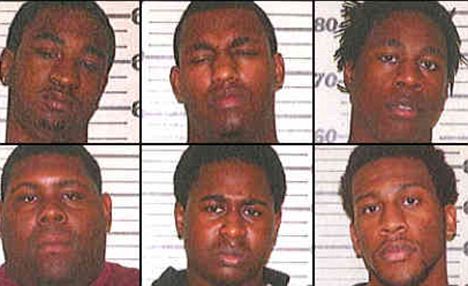
Can You Guess The Real Story Behind The Story?
By Steve Sailer
03/12/2011
Arthur Brisbane, the "Public Editor" of the New York Times, chastises an earlier NYT story:
Gang Rape Story Lacked Balance
The story quickly climbed The Times’s "most emailed" list but not just because of the sensational facts of the crime involved. "Vicious Assault Shakes Texas Town," published on Tuesday, reported the gang rape by 18 boys and men of an 11-year-old girl in the East Texas town of Cleveland.The viral distribution of the story was, at least in part, because of the intense outrage it inspired among readers who thought the piece pilloried the victim.
My assessment is that the outrage is understandable. The story dealt with a hideous crime but addressed concerns about the ruined lives of the perpetrators without acknowledging the obvious: concern for the victim.
While the story appeared to focus on the community’s reaction to the crime, it was not enough to simply report that the community is principally concerned about the boys and men involved — as this story seems to do. If indeed that is the only sentiment to be found in this community — and I find that very hard to believe — it becomes important to report on that as well by seeking out voices of professional authorities or dissenting community members who will at least address, and not ignore, the plight of the young girl involved.
Let’s consider the particulars:
The story by James C. McKinley Jr. reported that residents of the town noted the girl dressed "older than her age," wore makeup and fashions "more appropriate to a woman in her 20s" and hung out with older boys at the playground.
The story also quoted one resident, saying, "Where was her mother? What was her mother thinking?"
Referring to some of the defendants in the case, the same resident was quoted saying, "These boys have to live with this the rest of their lives." The fourth paragraph of the story laid out the basic themes of the story:The case has rocked this East Texas community to its core and left many residents in the working-class neighborhood where the attack took place with unanswered questions. Among them is, if the allegations are proved, how could their young men have been drawn into such an act?These elements, creating an impression of concern for the perpetrators and an impression of a provocative victim, led many readers to interpret the subtext of the story to be: she had it coming.
What in the world was going on with the initial story? Talking about the clothes the female was wearing and so forth has been a huge feminist no-no in reporting on rape (regular or statutory) cases for a generation or more. Why would the NYT violate feminist shibboleths in initially reporting this story? What facts are crucial to understanding the original NYT story’s remarkable concern for the males involved, yet aren’t mentioned in either the original story or the ombudsman’s critique?
Could it have anything to do with the unmentionable demographics of the accused rapists in this "working-class neighborhood" in Texas? (Judging from the NYT’s comments, I'd guess a lot of the emailing of the original article by NYT readers was of the "Look at what those vicious Red State Republicans do to little girls" variety.) Fortunately, we can go to a foreign country to find out what is happening in America and why it’s tying the NYT in knots. The London tabloid The Daily Mail conveniently lists the NYT’s omitted facts in its headlines:
Horrific gang rape of 11-year-old girl sparks racial tension as all the accused are black and the victim Hispanic — Activist claims arrests show ’selective prosecution' of African-American community-Meeting planned to discuss arrests receives 'death threats'- Outrage over newspaper report that claimed victim 'dressed older than her age, wearing make-up'- Defence attorney slammed for suggesting girl was a 'willing participant'
In other words, this is another Jena 6 story — a bunch of young black guys in a southern small town do something bad to somebody nonblack and then the national press turns it into a story about how these young fellows are, when you stop to think about it, the real victims.
In this case, however, the victim was not a 17-year-old white guy, but an 11-year-old Hispanic girl, so the NYT is getting called out on it, although in an extremely gingerly fashion. In contrast, the ludicrous coverage of the Jena 6 went on and on.
